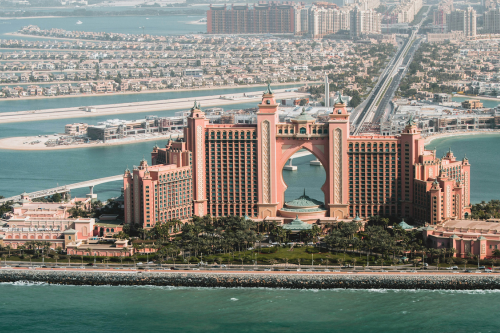The Unseen Risks & Challenges Ahead for Middle Eastern Aviation - What the Market Is Really Facing, But No One Is Talking About
Middle Eastern Aviation is enjoying unprecedented expansion opportunities - but the industry’s future success depends on its response to monumental long-term challenges this year.
Airlines are expected to see record-breaking success in 2025, with passenger numbers reaching 5.2 billion globally, representing a 6.7% year-on-year growth. Global airline revenues will surpass £0.8 trillion, with Middle Eastern airlines gaining the highest profitability margins at 8.2%. The region’s MROs are also predicted to grow to a value of $156billion by 2034.
Aviation leaders are striving to capitalize on these advantages by rising to the sector’s much discussed challenges, including supply chain bottlenecks, rising cost and resource strains, digital transformation and security threats. The sector is increasingly harnessing new technologies, innovative tactics and strong partnerships to solve its immediate problems. However, the industry has yet to acknowledge, let alone address, several much tougher challenges - and uncomfortable truths - that will determine its future prosperity.
The Unspoken Challenges Facing Aviation Leaders Sustainability - Actions Failing to Support Intent
The long-haul twin-aisle airliners characteristic of international travel sees Middle Eastern Aviation generate 10% of the sector’s total emissions, despite representing just 6% of the global fleet. Whilst the industry worldwide has increasingly welcomed tougher green legislation, and begun to introduce more fuel-efficient aircraft, the Middle East as a region is making slower progress.
The Middle East and Africa together produce only an estimated 100 million liters of sustainable aviation fuel annually, and the Middle East’s SAF production accounts for only 03.% of global demand as of 2025. Although SAF production is predicted to grow significantly in the coming years, outputs are expected to fall far below ambitious Government targets such as the UAE’s production goal of 700 million liters annually by 2031.
Aviation leaders know that SAF is vital to the environmental sustainability - and therefore the future economic prosperity - of the industry, but the net-zero transition will be expensive and difficult to scale. With production costs ranging from $6.40 to $19.01 per gallon, as of 2025, SAF costs are on average 3 to 7 times higher than conventional jet fuel.
Marie Owens Thomsen, Senior Vice President of Sustainability and Chief Economist at IATA, the global airline trade association, reinforces the urgency of increasing regional SAF production to meet global decarbonization targets. “We are seeing insufficient production of SAF across the world. On the current trajectory, we will be 100 million tonnes short in 2050. The rest of the globe should be exploring the lower-carbon fuels that occur naturally in the Middle East. If we can immediately co-process, the region is uniquely positioned to help the world take a big step forward.”
Jonathan Wood, Vice President for Commercial and Technical Management of Renewable Aviation at Neste, the world’s leading SAF producer, echoes Thomsen’s urgency but worries over the balance of quality and scale. “The interim goal of 10% of Aviation fuel from SAFs by 2030, set by the industry and national governments, will require construction of some 300 production plants globally. The University of Florence found that the need for the massive scale-up of production, investment and guaranteed availability of a variety of SAF feedstocks remain challenges to growth.
“We’re at the very beginning of this journey. We can’t wait until 2040 and beyond. We need to ramp up quickly and deliver significant volumes of SAF this decade. This year is a crucial moment for sustainable Aviation fuels, but the right strategy is essential for success. Lots of supply may mean pressure to set the environmental bar quite low. Equally, if we set that environmental bar really high, are we going to get the scaling that we need?”
The UAE's Sustainable Aviation Fuel General Policy and the UAE's SAF production commitments demonstrate appetite for a sustainable way forward. However, whilst regional governments have set strong targets, and the Middle East is building out production infrastructure, actual airline use of SAF remains a tiny proportion of overall jet fuel demand and lags below global usage. Europe’s ReFuelEU Aviation mandate and the Biden administration’s blending targets drove much higher airline SAF consumption relative to total fuel mix and encouraged major US airlines to increase annual SAF procurement. In contrast, the largest Middle Eastern airlines are only purchasing limited volumes of SAF for select flights.
The Solutions:
Government Legislation & Support to Ramp Up SAF Production - The region’s world-class Aviation hubs and solar-powered renewables potential ideally position the Middle East as both a future global SAF user and supplier.
The large-scale, mandatory SAF blending policies seen in the EU may seem ambitious, but the Middle Eastern Aviation sector is already demonstrating its readiness for the challenge. Saudi Arabia’s Red Sea International Airport represents one of the highest SAF blends worldwide - up to 35% of its commercial jet fuel supply - and offers SAF to all airlines operating through the airport.
Accepting Short-Term Costs for Long-Term Prosperity - Improved production efficiencies will see SAF costs drop from 7 times as much as conventional jet fuel to just 1.5-2 times by 2023. However, double conventional fuel costs are still higher than many in the industry are currently willing (or able) to pay.
Danny Brooks MBE, CEO of Middle Eastern Aviation Recruitment Provider VHR, recommends, “With Aviation’s profit margins lower than other sectors that are further ahead in their sustainability journey, airlines must increasingly prepare to absorb the costs of technologies that improve SAF volume and quality. When costs are passed on to customers, passengers must be educated on the value of SAF, to protect business continuity and involve passengers in the sustainable future of Aviation.”
Creating & Maintaining Close Partnerships to Collaborate - Danny continues, “Partnerships between regional Governments and Aviation businesses are essential to co-create regulation with realistic targets and build the support mechanisms to achieve them. Enhancing legislator understanding of production costs and timelines will enable access to the necessary funding for renewables infrastructure and resulting innovation.”
Inconsistent regulatory frameworks and lack of substantial government support is discouraging investors from committing to large-scale SAF project funding. Industry voices like Thomsen are encouraging governments in the region to develop policies that attract oil producers to invest in co-processing.
SATORP, a joint venture between Aramco and TotalEnergies, evidences the potential of Aviation and Energy production partnerships. Officially recognised with an International Sustainability and Carbon Certification, SATORP aims to produce 1.5 million tons per annum of SAF from used cooking oil by 2030.
Aramco President & CEO Amin H. Nasser shares, “Many in the energy industry are shying away from capital investments. We see petrochemicals playing a significant role in the vision for sustainable Aviation. We’re using cutting-edge downstream technologies to produce advanced chemicals more efficiently and expand our value chain.
“This expansion is essential to Saudi Arabia’s economic growth and diversification objectives. Partnering global industry leaders like Total, and supported by the government's Shareek program, we are seeing more local and global private sector companies invest. Whether local investments from companies within the Kingdom, or from Europe and Asia, Aramco continues to see tremendous value in collaboration, enhancing our globally competitive and vibrant local energy sector.”
The Long-Term Viability of the Multiple Delivery Hub Model
Aviation’s slow adoption of sustainable fuels, materials and technologies poses a risk to the future of the Middle East’s multiple delivery hub model and aggressive expansion plans.
The hub-and-spoke model, strategically located and underpinned by strong investments in infrastructure, currently positions the Middle East as a global connecting centre. However, the model’s resilience depends on ambitious capacity growth, which requires significant SAF investments to scale fast enough for widescale adoption. Unless greener fuels and more efficient infrastructure are rapidly deployed, shared systems and facilities will face increasing strain.
Whilst integrated ecosystems, often supported by government ownership and investment, enable co-operative infrastructure expansion and both cost and operational efficiencies, the risk of future overcapacity looms over current collaborative practices. Rather than broadening market demand, the rapid expansion of multiple large hubs in close proximity could cause friction that threatens operational success and economic prosperity.
Locally based airlines have historically focused on connecting traffic between regions. Doha accounts for 85% of connecting traffic, whilst Emirates represents over half of all traffic and Turkish Airlines flies to more countries than any other airline globally. New national carrier Riyadh Air aims to attract global point-to-point and connecting traffic, striving to serve key European and Asian hubs by 2030. More regional competition in the form of new airline entrants and airport expansions, such as Dubai’s five runway vision, will require more competitive products, forcing lower airfares and faster connectivity. Lower-cost and legacy airlines could suffer from the monopolisation of larger carriers that can compete on scale and absorb higher operating costs.
Director General of the International Air Transport Association Willie Walsh comments, “With cities like Dubai, Abu Dhabi and Riyadh implementing ambitious airport expansion plans, questions arise regarding the region’s ability to accommodate multiple major hubs. Whilst two significant hubs could flourish, sustaining a third could prove challenging due to geographic proximity and overlapping market dynamics. Dubai is likely to remain the primary hub, while Riyadh may prioritize catering to local needs rather than focusing on transfer traffic.” John Grant, Chief Analyst at travel data provider OAG warns, “The mix of low-cost airlines and increased capacity will create a consumers’ market with lower airfares. High-quality airlines that bring state-of-the-art aircraft will mean a new wave of sustainable Aviation, potentially leaving some airlines scrambling to survive.”
With 160 non-domiciled and almost 40 locally-based carriers, airlines will also face competition for an ever-pressing shortfall of talent:
-
18,000 more pilots will be required in the Middle East in the coming years
-
The unmet demand for aircraft maintenance technicians is skyrocketing. Recent reports reveal 234,000 open positions across Aviation jobs in the region, including AMTs
-
The rapid retirement of experienced engineers, especially during and post-Covid, is driving the MRO experience gap: younger workers lack practical industry-specific expertise from more senior technicians
-
Boeing predicts a need for around 60,000 additional aircraft engineers across the Middle East by 2040.
The Solution: Long-Term Investment in Training & Collaborative Partnerships
Regional collaboration around SAF production is key not only to meeting sustainability targets but in achieving ambitious expansion plans. Despite increasing competition amongst airlines, collaborative capacity planning between governments and Aviation businesses themselves is the optimum path to the sustainable and efficient operation the sector demands.
VHR’s Danny Brooks advises, “One of the primary solutions to the competition for Aviation skills lies in upskilling existing workers. Structured training programmes benefit junior engineers and technicians with on-the-job, hands-on mentoring from current senior engineers before they retire. Some MROs are facilitating cross-skilling between different roles, such as line and base maintenance. Clear career progression pathways through dedicated training programmes are engaging more junior Aviation workers and retaining younger talent.”
Partnerships with regional Universities and apprenticeship providers is vital to growing local talent pools. The Emirates Aviation University is incorporating emerging technologies into Aviation management programmes, and has built Master's degrees in Aviation Safety and Aviation Security in collaboration with the Dubai Airport police. The University’s Vice Chancellor Ahmad Al Ali shares, “The future of Aviation employment will be influenced by advanced technology that informs data-driven executive decisions. Universities like ours are responding by offering new programmes in fields like Artificial Intelligence and Data Science. We sat together with the Ministry for a couple of years before we accredited these two programmes.”
“We design our Aviation management curriculum based on the requirements and advice of Emirates Airlines. Students receive four months of hands-on training in the hangar, not just on software. Internships are very important to give our students the opportunity to apply what they learn in the classroom to the workplace."
Widening Talent Pools Means Recruiting & Developing Female Aviation Specialists - But Barriers to Career Progression Require Systemic Change
Workplace diversity is a major factor underpinning the experience gap, and hiring from historically underrepresented groups could present the ideal solution. Whilst 42% of the global Aviation workforce is female, airport operations and aircraft manufacturing have lower female shares, closer to 18–19%. More broadly in the Middle East and North Africa region, women represent an average of around 33% of the Aviation workforce.
Although the sector is increasingly welcoming and championing the careers of female professionals, most businesses are not yet addressing the less visible but more significant gender imbalances in the industry. Women in Middle Eastern Aviation face a multitude of barriers including:
-
Underrepresentation in Senior Roles - Whilst women constitute around 42% of the sector in places like the UAE, female professionals remain underrepresented in senior leadership, pilots and highly technical positions. Board seats held by women in the Arabian Gulf states are less than 7%, compared to about 20% globally.
-
Career Development - Underrepresentation in senior leadership creates a lack of role models and mentors. Across sectors, 80% of female business leaders in the UAE have struggled to break through the ‘glass ceiling’ in their organisations. Only 1 in 4 of the UAE’s female workers receive regular training and development, with 3 in 4 reporting that they are not offered regular career reviews or promotion chances.
-
Direct Discrimination and Implicit Bias - 70% of women across the Gulf Cooperation Council countries name gender bias and stereotypes as major challenges to workplace advancement. Indirect biases, which are more difficult to address, limit women's access to decision-making roles, creating a cycle of exclusion. Female Aviation professionals currently have little influence on the working environment, and cannot begin to build a more inclusive future culture without the influence that senior leadership positions provide.
-
Workplace Safety and Harassment Concerns - The United Nations find that 40% to 99% of women in Middle Eastern countries report having experienced sexual harassment, including at work across industries. Workplace harassment is still chronically under-measured in the region, with the problem thought to be widespread in highly technical and traditionally male-dominated sectors such as Aviation.
The Solution - Taking Inspiration from Early Pioneers & Investing Long-Term in Women’s Career Paths
Etihad Airways have long demonstrated their commitment to hiring women across functions and championing female career development. Fatma Almheiri became Etihad’s first female Emirati country manager and her career trajectory soon spanned senior executive roles including Vice President of Sales for the UAE, Middle East and Africa region. The airline’s first group of female Emirati cadets began training in 2007, one of whom was Aisha Al Mansoori. Gaining 6,000 flight hours on different aircraft and becoming the first woman to pilot the Airbus A380, Al Mansoori became the first female Emirati captain in history.
Aisha Al Mansoori’s own professional success was inspired by that of her older sister, Major Mariam Al Mansouri, who became one of the first women to join the United Arab Emirates Air Force academy and the UAE’s first female fighter pilot. Aisha Al Mansoori advocates for more role models and mentors to support female Aviation professionals: “Growing up, becoming a pilot was not really an option for Emirati women. I was lucky that my sister started flying when I was in high school. I went with her to an air show: when I saw the aircraft and the pilots, I knew that’s what I wanted to do for the rest of my life.”
The SkyTeam alliance, which includes Saudia and Middle East Airlines, are providing training and mentorship through the RISE Women’s Leadership Development Program. IATA’s 25by2025 programme strives to increase female representation in senior and technical roles with key reporting on gender diversity metrics that reveal and address disparities in pay and advancement.
VHR’s Danny Brooks recommends, “To fully capitalize on the skills of its female workforce, the Aviation sector must face the harsh reality of widespread cultural change. The career efforts of female Aviation professionals are not being matched by employers. Ambitious and dedicated workers deserve the investment of continuous specialist training, whether male or female.
“Without real-life examples of women succeeding in their own career paths, and the advice and guidance to navigate gender barriers, female professional advancement in Aviation will be limited. Where role models and mentors don’t yet exist, Aviation companies have the opportunity to connect their female talent with mentors across industry networks. Proactively supporting the career advancement of female workforces will not only attract but develop the diverse talent pools that airlines, airports and MROs urgently need.”
The Solution to Middle Eastern Aviation’s Toughest Challenges - Finding the Right Partners to Shape the Future Workforce
Danny continues, “The fastest-growing airlines and MROs are fundamentally changing their approach to building their workforces. Just like the Aviation sector as a whole, Middle Eastern industry leaders are investing in the capabilities they need for today and for tomorrow, to serve high demand and harness innovation opportunities for success.”
VHR partners airlines and MROs worldwide to find and create top Aviation talent.








